Project Update: July 7, 2023
First Successful Hearing Tests Conducted with Minke Whales will Improve Conservation and Protection of Baleen Whales Globally
URE, NORWAY – The scientific team collecting important and first-ever measures of hearing in baleen whales has concluded its third field season in Norway.
The multi-national team now has data on the hearing abilities of two minke whales (Balaenoptera acutorostrata). With the initial whale, the team collected the first auditory brainstem response (ABR) in any baleen whale. With the second whale, the team collected both the ABR and information on the frequency range of hearing. The results were surprising. The scientists found that minke whales have a much higher frequency limit to their hearing range than previously believed based upon their ear anatomy and the frequencies at which they vocalize.
The non-invasive hearing tests were conducted by placing sensors on the surface of the skin with suction cups that allowed the whale’s brainwaves to be recorded when it heard a sound played by the researchers. The procedure is similar to hearing tests regularly performed with dolphins, porpoises, and even newborn human babies.
The team was particularly pleased that they were able to assist the first whale, which had a fishing net entanglement around its upper rostrum (Figure 1). It was clear that the whale had been entangled for some time; tissue had grown around the netting, which was cutting into the animal’s rostrum. The team was able to successfully remove the entanglement (Figure 1, bottom). Without their intervention, the whale may not have survived. Satellite telemetry has shown that both whales have continued normal behavior following the studies (Figure 2).
The research effort, led by the National Marine Mammal Foundation (NMMF), the Norwegian Defense Research Establishment (FFI), and LKARTS-Norway, is an effort to acquire fundamental information necessary to establish scientifically based regulatory guidelines to better mitigate ocean noise exposure for baleen whales. The information will fill a knowledge gap that is critical to protecting all baleen whales from anthropogenic ocean noise. The research is funded by the Office of Naval Research, Bureau of Ocean Energy Management, National Oceanic and Atmospheric Administration’s National Marine Fisheries Service, US Navy Living Marine Resources, and the US Marine Mammal Commission through the Subcommittee on Ocean Science and Technology Interagency Task Force on Ocean Noise and Marine Life.
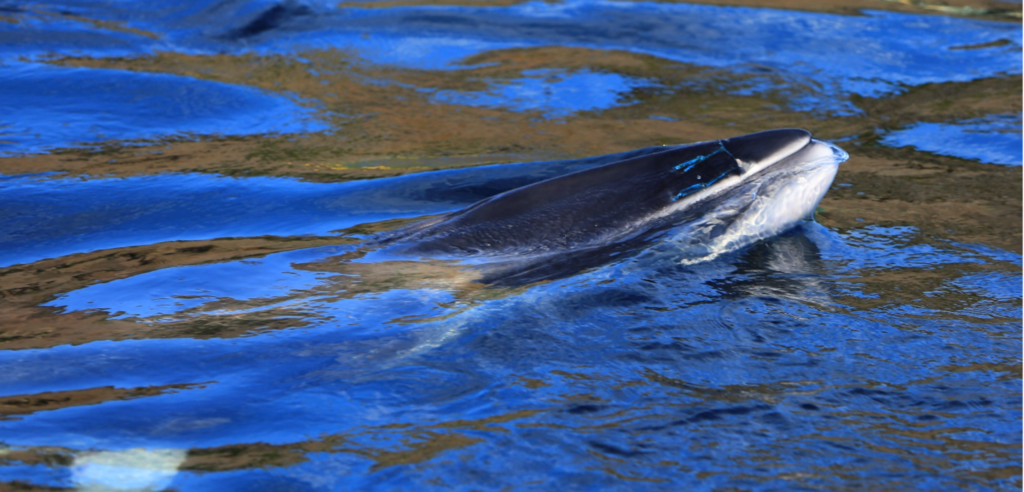
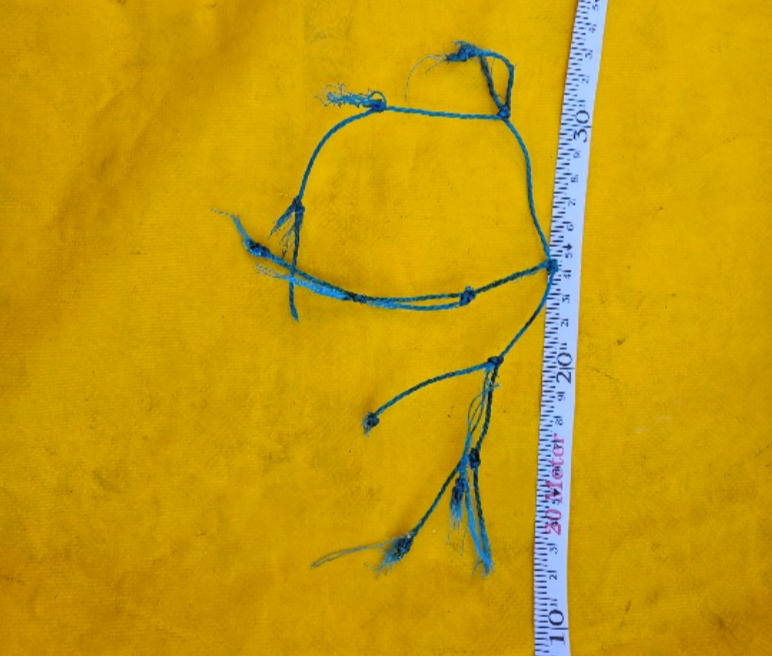
Figure 1. (top) Net entanglement of the first hearing test subject. The net was removed during the hearing test procedure. (bottom) Net that was removed from the whale’s upper rostrum.

Project Background
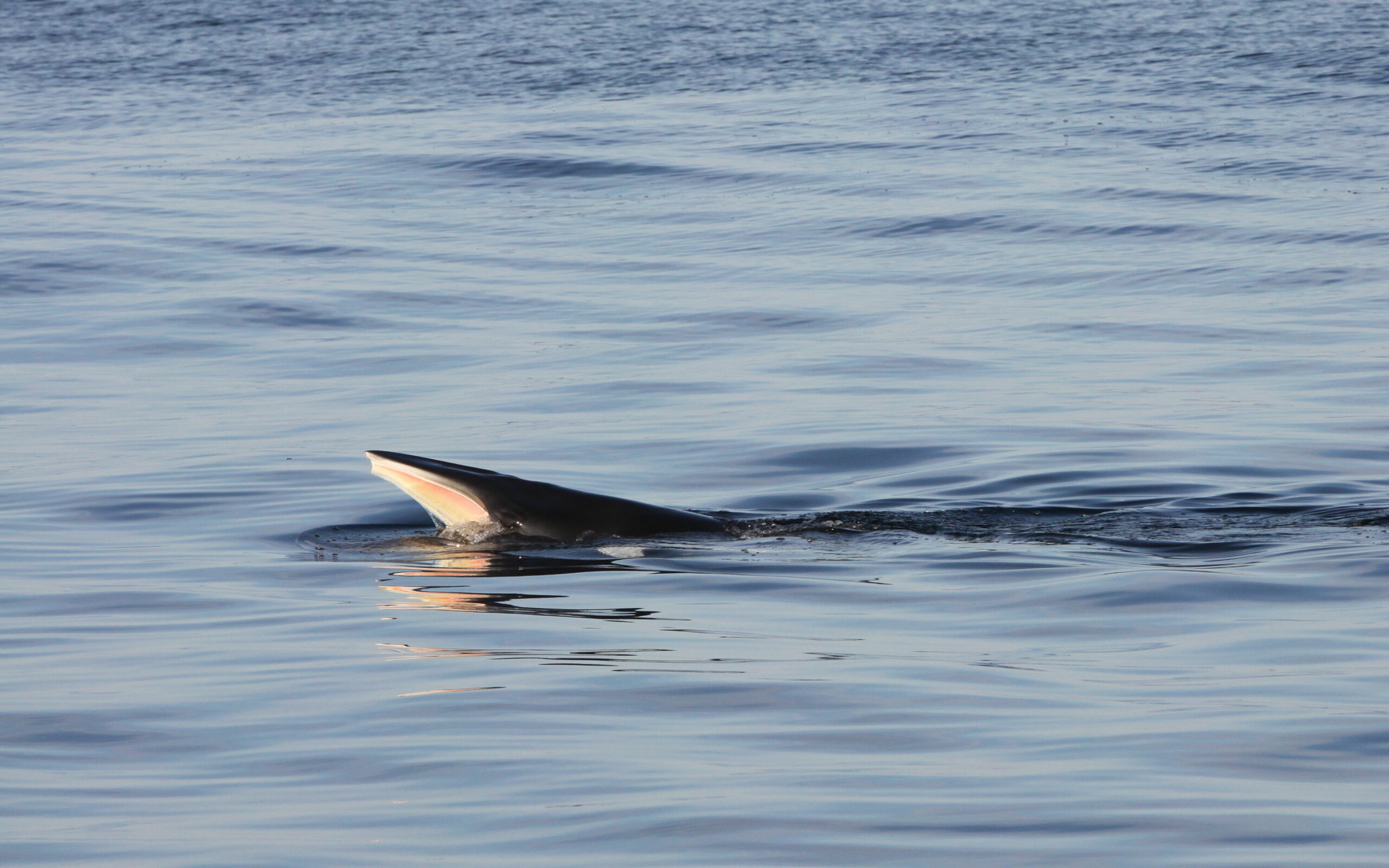
Over the last century, humans have increasingly put sound into the ocean. Human-made sound, or anthropogenic sound, is intentionally used to explore the ocean floor, to search for oil, in scientific research, in fisheries, and for military purposes (e.g. sonar). A dramatic increase in the use of cargo ships for transporting commercial goods and a proliferation of recreational vessels have also contributed to an increase in ocean sound in many parts of the world. Because sound travels efficiently through water, sounds produced in the ocean can travel great distances and can be detected thousands of miles away from the source of the sound if the sound is of a sufficiently high level.
Baleen whales, otherwise called mysticete whales, are the largest animals on earth.
These whales filter feed using baleen, which is a feathery, filter-like comb structure within the mouths of the whales. Baleen whales rely on sound to communicate, forage, and navigate the world’s oceans. Anthropogenic sound can potentially affect a baleen whale’s hearing, change its behavior, and interfere with its ability to communicate, forage, and navigate. It can potentially hinder a baleen whale’s ability to hear and avoid ships, and chronically high levels of sound might elevate levels of stress hormones that affect a whale’s health and ability to reproduce. In short, anthropogenic sound is noise to baleen whales and it has the potential to negatively affect them. As many baleen whales are endangered and their rates of producing calves are low, there is reasonable concern as to how anthropogenic noise might affect baleen whales and their populations.
Anthropogenic ocean noise covers a broad range of frequencies (i.e., from low to high pitches); whales might not be able to hear some of these frequencies of sound, but other sounds might occur at frequencies to which whales are very sensitive. Understanding what a whale can hear is the first step in determining what kinds of anthropogenic ocean noise might affect them. This knowledge ultimately helps in the development of measures to protect the whales from ocean noise. Importantly, no test of the frequencies that baleen whales can hear has ever been successfully performed, and the hearing abilities of baleen whales have only been estimated from ear anatomy and observed behavioral responses to sound exposure. As a result, the SOST Interagency Task Force on Ocean Noise and Marine Life has identified a lack of knowledge about baleen whale hearing as a critical impediment to protecting baleen whales from ocean noise.
The National Marine Mammal Foundation (NMMF) in collaboration with the Norwegian Defense Research Establishment (FFI) is undertaking an effort to acquire the first audiogram (hearing sensitivity curve) for a baleen whale. The research is funded by the SOST Interagency Task Force on Ocean Noise and Marine Life, which consists of multiple agencies including the Office of Naval Research, Bureau of Energy Management, National Oceanic and Atmospheric Administration, US Navy Living Marine Resources, and the Marine Mammal Commission. The effort will provide the first direct measures of hearing across frequency in any baleen whale and will be a step toward addressing a knowledge gap that is critical to protecting baleen whales form anthropogenic ocean noise.
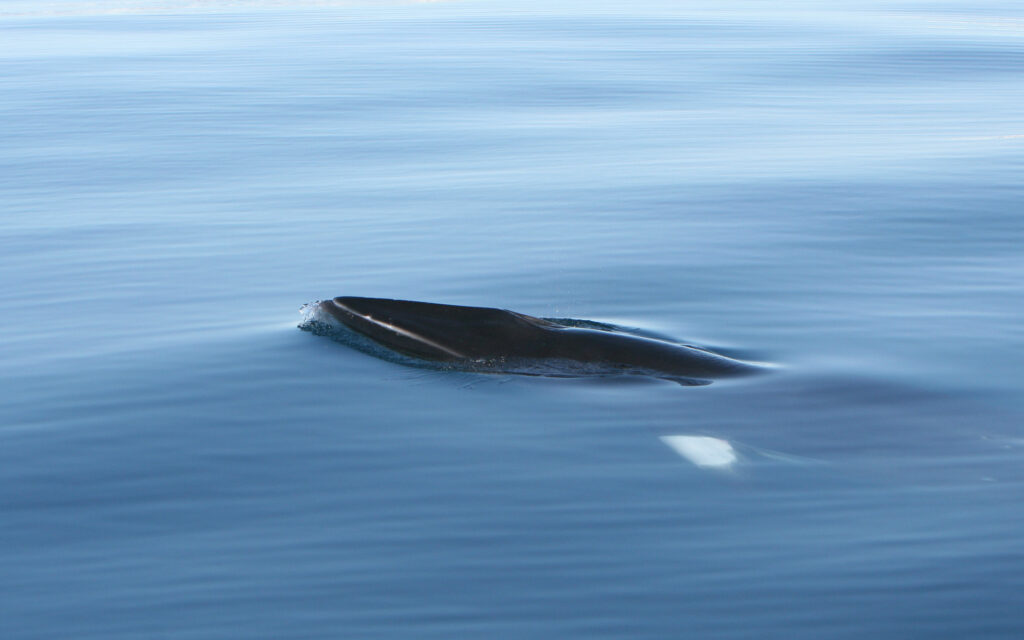
The Project
The project will take place over several years in northern Norway during the late spring and early summer. During this time, the smallest of the baleen whales, the minke whale (Balaenoptera acutorostrata), migrates northward to Arctic waters. The research team will perform a catch-and-release study in which adolescent minke whales will be caught and temporarily held within a natural body of water barricaded by nets. The whale will then have its hearing tested by using auditory evoked potential (AEP) methods. After the test, the whale will be released to continue its migration.
The AEP method monitors electrical signals produced by the brain when it hears a sound. These tests are regularly performed on newborn human babies, and are also now a commonly used veterinary tool for testing the hearing of dolphins, porpoises, and other small whales. The hearing tests with minke whales will be conducted by NMMF scientists, who have extensive experience in performing these types of tests and are world leaders in the study of marine mammal hearing.
Adolescent minke whales will be targeted for this study. Adolescent minkes range from 3-5 m in length and are similar in size to adult beluga whales, for which the AEP method has been successfully used many times. Testing with the smaller individuals makes handling the whale easier and increases the chances of successfully performing the hearing tests.
Whales will be captured between two small islands that the whales are known to pass between on their migration. Once a whale passes between the islands, the entrances will be blocked with barrier nets. The waterway is large and a whale will have plenty of room to freely swim and dive while contained between the islands. After a marine mammal veterinarian has observed the whale and made a decision that it is healthy for testing, another net that spans the width of the waterway will be deployed between two boats. This net will be slowly maneuvered to direct the whale to an opening in a circular fish farm, which is a large netted enclosure for holding fish. When the whale enters the fish farm, the opening to the fish farm will be closed. The net of the fish farm can then be pulled up under the whale to create a hammock. This safely limits movement of the whale while also keeping it at the surface so its blowhole is kept above water but the lower body remains submerged. The hearing test is conducted while the whale is in the hammock. After the hearing test is completed, the whale will be released back into the fish farm and then back into the basin. The barrier nets to the basin are then opened so the whale can continue its migration.
Each whale that has its hearing tested will be fitted with a satellite tag prior to its release. This will allow researchers to monitor the whale to ensure that it continues on its normal migration. The tags should allow researchers to follow the whales for several months after testing.
Additional Project Updates
Project Update: June 13th, 2023
Minke Whale Hearing Project to Begin in Norway
The multi-national project to study the hearing of minke whales is set to begin off the coast of Norway. Acquiring audiograms (hearing sensitivity curves) will fill a critical knowledge gap essential to protecting all baleen whales around the world.
Anthropogenic sound can potentially affect the whales’ hearing, change their behavior, and interfere with their ability to communicate, forage, and navigate. Chronically high levels of sound could elevate levels of stress hormones that affect the whales’ health and ability to reproduce.
Prior to the start of project operations, severe weather damaged the Norwegian test facility and, sadly, a minke whale died as a result. The lead scientists placed an immediate hold on the project and called for a thorough review of all project protocols and procedures.
The Norwegian permitting authorities, the NMMF Institutional Animal Care and Use Committee, and the US Navy Bureau of Medicine completed a review of the incident, which was a result of exceptionally severe weather conditions and very strong lunar tidal currents. The scientific team implemented additional safety measures to further fortify the facility and help prevent facility damage in the face of severe weather and strong currents.
Hearing information obtained from this study will be used by federal regulatory agencies, scientists, and conservationists to improve management efforts related to ocean noise and its potential impact on baleen whales in our oceans. Six species of these whales are currently classified as endangered.
The importance of this hearing study and its significance to the conservation and protection of baleen whales was emphasized by a group of marine mammal scientists who sent a letter of support to the Norwegian Broadcasting Corporation (NRK). The scientists said “. . . the current project is groundbreaking in nature and will provide opportunities to study aspects of these animals’ biology that have not yet been explored.”
Project Update: June 7, 2023
Minke Whale Hearing Project Placed on Hold in Norway
During preparations for an important multi-national project to test the hearing of minke whales (Balaenoptera acutorostrata) off the coast of Norway, severe weather with gale force winds and extreme tidal currents damaged the project testing site. The scientific team is deeply saddened to report that while assessing the storm damage, they discovered a single minke whale had become entangled and died in a barrier line that had broken free as a result of the severe weather conditions.
The Norwegian Defence Research Establishment (FFI) and the National Marine Mammal Foundation (NMMF) are leading an effort to acquire the first audiogram (hearing sensitivity curve) for a baleen whale. The effort is providing the first direct measures of hearing in any baleen whale and will be a step toward addressing a knowledge gap that is critical to protecting baleen whales from anthropogenic ocean noise.
Dr. Petter Kvadsheim of FFI said, “Key precautions and significant planning went into every aspect of the hearing test project. Our team was devastated when they realized a minke whale died in a barrier line damaged by the severe weather, prior to the official start of this year’s hearing test project.”
All protocols and procedures will be reviewed by the Norwegian permitting authorities, the NMMF Institutional Animal Care and Use Committee, and the US Navy Bureau of Medicine, in consultation with the agencies financially supporting the project. The project will remain on hold until the incident has been thoroughly reviewed. Whether the project will continue will be determined as part of the review process. In the meantime, the project testing site has been repaired to ensure its safety.
Dr. Dorian Houser of NMMF said, “Our scientific team is heartbroken by this loss. Animal health and welfare is our highest priority, and we have placed the project on hold while a formal review is conducted.”
The research is funded by the Subcommittee on Ocean Science and Technology Interagency Task Force on Ocean Noise and Marine Life, which consists of multiple agencies including the Office of Naval Research, Bureau of Ocean Energy Management, National Oceanic and Atmospheric Administration’s National Marine Fisheries Service, US Navy Living Marine Resources, and the US Marine Mammal Commission.
The international scientific team remains committed to protecting minke whales and other baleen whales and managing the impact of ocean noise on these kinds of whales.
Project Updates 2022
The field effort for 2022 concluded with significant progress toward obtaining the first-ever audiogram on a baleen whale. A total of 41 whales were observed near the catch basin this year. Two whales were caught. Corralling procedures from the basin to the fish farm, where the hearing test will occur, were performed with both whales. The technique for corralling was improved following the first attempt, during which the whale escaped the basin, and the second whale was successfully corralled into the fish farm.
The second whale was then placed in a net hammock for the hearing test by pulling the fish farm net up from underneath the whale. However, because the animal showed signs of distress, it was released back into the fish farm and then the catch basin per our animal welfare protocols. The whale was held for 26 minutes.
We now know how to temporarily catch and hold minke whales for hearing tests. Over the next year, we will be analyzing our approach to determine how best to minimize stress to the whales due to the capture procedure. As minke whales are a new species for catch-and-release efforts, we are taking a slow, deliberate and protective approach to handling the animals.
Project Update 2021
-

Aerial view of the diverting nets and catch and release (C&R) site. Photo: Espen Wang-Naveen / FFI. -

A small minke whale enters the C&R site. Photo: Victoria Pynevinje
The first field season of the SOST minke whale hearing project has come to a close. This season was focused on providing proof-of-concept that the system for catching and releasing whales would work and provide a safe environment for testing. Almost half of the season was used to set up and optimize the catch and release system, which consisted of a system of nets used to guide the whales into a basin that could be sealed once entered. Nearly 1.7 km of netting weighing more than 20 tons were deployed.
Twenty whales were observed in the area during the month of setup and operation, validating local knowledge about the migratory patterns of the whales used in the conceptual design of the system. Three whales entered the catch basin prior to completion of the catch and release (C&R) site and three others entered the basin after the team completed the C&R site and entered “catch” mode. This importantly demonstrated that whales migrating through the area could be diverted into the C&R site by the net system. Two of the three whales entering the C&R site were safely caught demonstrating the feasibility of containing whales once in the basin.
The information obtained from this first field season was critical to demonstrating proof-of-concept of the temporary catch and release of minke whales. No hearing tests were attempted this year, but the team will be shifting focus next year to this final phase of the experimental protocol. The hearing sensitivities will be the first ever measured for any baleen whale and will have important consequences to managing the impact of ocean noise on baleen whales.
Frequently Asked Questions
Human-made sound can potentially affect a whale’s hearing, change its behavior, interfere with its ability to communicate, affect its foraging, navigation, and avoidance of ships, and potentially cause it to be stressed. Sound sources put into the ocean by humans cover a broad range of frequencies; whales might not be able to hear some of these frequencies of sound, but other sounds might occur at frequencies to which whales are very sensitive. Understanding what a whale can hear is the first step in determining what kinds of human-made ocean noise might affect them, which ultimately helps in the development of protection measures. The SOST Interagency Working Group on Ocean Sound and Marine Life has identified a lack of knowledge about baleen whale hearing as a critical impediment to protecting baleen whales from ocean noise.
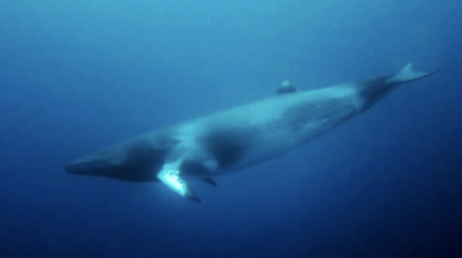 The baleen whales are the largest species of whale and there are no direct measurements of hearing in these animals. The minke whale is the smallest of the baleen whales and provides the best opportunity for directly performing a hearing test in this group of animals. Minke whales predictably migrate northward along the coastline of Norway during the early summer, providing the best opportunity to perform a catch-and-release study of hearing.
The baleen whales are the largest species of whale and there are no direct measurements of hearing in these animals. The minke whale is the smallest of the baleen whales and provides the best opportunity for directly performing a hearing test in this group of animals. Minke whales predictably migrate northward along the coastline of Norway during the early summer, providing the best opportunity to perform a catch-and-release study of hearing.
Hearing is tested using the auditory evoked potential (AEP) method. An AEP is an electrical signal produced by the brain when it hears a sound. This method of testing hearing is similar to that used in newborn babies, and it is now commonly used as a veterinary tool to test the hearing of dolphins, porpoises, belugas, and other toothed whales. The hearing tests in most toothed whales and in human babies are performed with sensors placed on the surface of the skin. This method will be attempted with the minke whales first. If this method does not work, subcutaneous sensors will be used.
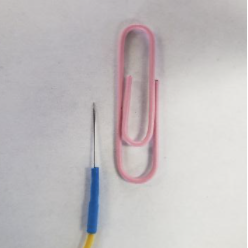 The subcutaneous sensors are small needles placed underneath the skin and into the blubber layer. The diameter of the largest needle is extremely small – about the diameter of an acupuncture needle (see the figure for an example). These are the same types of sensors sometimes used in human studies of hearing and are commercially available from medical supply companies. The needles are tiny compared to currently accepted procedures for tissue biopsy and tagging of large whales. Their insertion probably won’t be felt by the whale, and if it is felt, the discomfort will be quick and minor (akin to having acupuncture). There is no risk of injury to the whale through the use of these sensors; NMMF scientists have used them many times in the study of marine mammal hearing, without incident.
The subcutaneous sensors are small needles placed underneath the skin and into the blubber layer. The diameter of the largest needle is extremely small – about the diameter of an acupuncture needle (see the figure for an example). These are the same types of sensors sometimes used in human studies of hearing and are commercially available from medical supply companies. The needles are tiny compared to currently accepted procedures for tissue biopsy and tagging of large whales. Their insertion probably won’t be felt by the whale, and if it is felt, the discomfort will be quick and minor (akin to having acupuncture). There is no risk of injury to the whale through the use of these sensors; NMMF scientists have used them many times in the study of marine mammal hearing, without incident.
Although there is risk to catching any wild animal, adolescent minke whales will be targeted for this study to minimize risk and increase the chances of successfully performing hearing tests. Adolescent minkes range from 3-5 m in length and are similar in size to adult beluga whales, for which the AEP method has been successfully used. Similar capture techniques have been used with wild belugas and dolphins for AEP hearing tests as part of population health monitoring. The research team has developed safety protocols based on these prior experiences and has also convened specialist groups for developing protocols on whale handling.
A series of barrier nets will be used to passively and safely guide a migrating whale through a waterway between two small islands. The far end of the waterway will be barricaded with another net that spans the distance between the islands. As a whale enters the waterway, a third net is pulled across the entrance so that the whale is contained within the waterway. The waterway is large and the whale has plenty of room to freely swim and dive.
After a marine mammal veterinarian has observed the whale and made a decision that it is healthy for testing, another net that spans the width of the waterway will be deployed between two boats. This net will be slowly maneuvered to direct the whale to an opening in a circular fish farm, which is a large netted enclosure for holding fish. When the whale enters the fish farm, the opening to the fish farm is closed. The net of the fish farm can then be pulled up under the whale to create a hammock. This controls the movement of the whale at the surface, keeping its blowhole above water but with the lower part of its body submerged. The hearing test is conducted while the whale is in the hammock. After the hearing test is completed, the whale is released back into the fish farm and then back into the basin.
The claim that the whales will be stunned is incorrect. There is no plan to stun the whales. The research team has worked with experienced large whale veterinarians and specialists in marine mammal anesthesiology to establish a sedation protocol. The sedation protocol is only to be used if the whale becomes a danger to itself or research personnel. The sedative that would be used is in the same family as Valium; however, the researchers intend to perform the hearing tests without any sedation. The approach is based on prior observations of minke whales caught in pound nets in which the animals behaved calmly until released.
Each whale that is tested will have a satellite tag attached to it so the whale can be tracked for months after the hearing test. This will allow researchers to monitor the whale’s behavior and to determine if there are any lasting changes in its behavior following the hearing test.
The claim that the research is funded by the oil and gas industry is incorrect. Two sponsors (ONR and LMR) are part of the US Navy, which has an interest in reducing and minimizing the impact of its sound- producing activities on marine mammals. The US Navy has spent several decades trying to understand how human-caused sound in the ocean affects marine life. The US Navy is the leading sponsor of marine mammal research, globally, and is continuing its efforts to collect information to help it be a better steward of the environment.
BOEM and NOAA regulate ocean noise producers and their impacts on marine mammals. The information from this study is necessary for them to regulate impact of various noise producers on marine mammals. It is important to note that BOEM regulates the oil and gas industry.
The MMC provides independent oversight of conservation policies and programs performed by federal agencies, including those that regulate impacts on marine mammals. The information obtained from this study will be used by them in advising federal bodies on issues related to marine mammals, and baleen whales in particular.
Permits are required to perform research with marine mammals to ensure that the research is needed and conducted responsibly. Because the whales are being tested in the coastal waters of Norway, the permits required to study the whales are from Norwegian regulatory agencies. These include the Norwegian Food Safety Authority, Norwegian Directorate of Fisheries, and the Norwegian Coastal Administration. In addition, all procedures have been approved by the Institutional Animal Care and Use Committee of the National Marine Mammal Foundation and have been reviewed and approved by the US Navy Bureau of Medicine.




